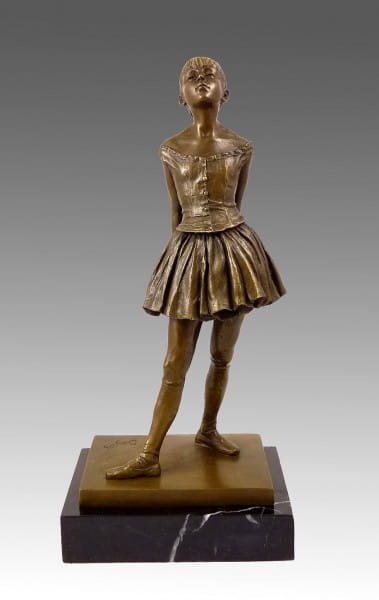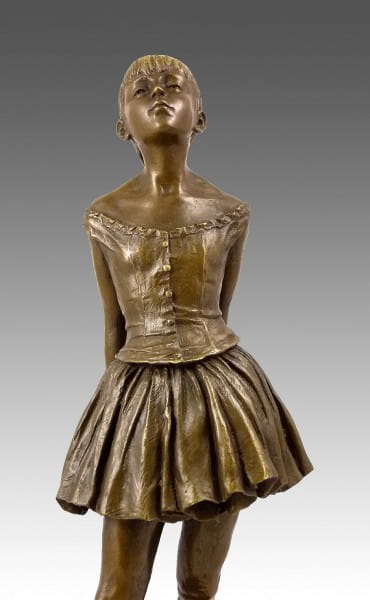Prices incl. VAT, free shipping worldwide
Ready to ship today,
Delivery time appr. 3-6 workdays










Product description
"Little Dancer of Fourteen Years - Edgar Degas"
| Weight | 5,5 kg |
Timeless Elegance – Little Dancer of Fourteen Years by Edgar Degas - Signed
The Bronze Sculpture – Little Dancer of Fourteen Years stands as one of the most iconic achievements in nineteenth-century art. This Degas Sculpture portrays a young ballerina in a natural yet commanding stance, her head lifted and arms folded gently behind her back. The delicate folds of her skirt and the subtle turn of her neck capture both the discipline and vulnerability of a dancer on the threshold of womanhood. Light moves softly across the bronze surface, revealing fine details that echo the original wax model. More than a simple portrait, this Degas Statue Dancer embodies the fleeting balance between childhood and the demands of professional ballet.
Creation of a Revolutionary Work
Between 1875 and 1880, Edgar Degas shaped the first version of the Little Dancer of Fourteen Years in wax, an audacious departure from traditional sculpture. When he exhibited the piece in 1881, it featured a real fabric tutu and a wig of human hair, shocking Parisian audiences accustomed to classical marble. Although the original remained unique during his lifetime, carefully supervised bronze casts were created after his death, preserving every nuance of the wax surface. Each Ballerina Statue Degas retains the quiet intensity of that first daring presentation. Today, these bronzes represent a milestone in modern art, where realism and experimentation merged in a single unforgettable Edgar Degas Artwork.
The Artist’s Parisian Roots
Born on 19 July 1834 in Paris, Edgar Degas grew up in a cultured, affluent family that valued both literature and the visual arts. His father, a banker of Neapolitan descent, encouraged an education steeped in tradition, while his mother’s New Orleans heritage introduced him to a wider cultural horizon. Degas studied at the Lycée Louis-le-Grand and the University of Paris before entering the École nationale supérieure des beaux-arts, where he absorbed the rigorous discipline of classical drawing. This blend of intellectual curiosity and technical mastery shaped every later Degas Sculpture and painting. His refined upbringing gave him both the confidence and the critical eye to challenge artistic conventions.
Education and Artistic Evolution
Early travels to Italy deepened Degas’s admiration for Renaissance masters, sharpening his understanding of anatomy and perspective. Returning to Paris, he became a pivotal figure among the Impressionists, though he always preferred to call himself a realist. His fascination with movement—whether in racehorses, laundresses, or ballet dancers—guided his artistic path. The Degas Statue Dancer reflects this passion, capturing the dancer’s stillness at the very moment before motion begins. Through careful observation and innovative technique, Edgar Degas Artwork bridges the worlds of painting and sculpture, offering a tangible expression of the rhythms of modern life.
Technique and Transformation
The posthumous bronzes of the Little Dancer of Fourteen Years were produced using the traditional lost-wax, or cire-perdue, method, which faithfully reproduces the textures of Degas’s original wax. The process allowed artisans to preserve the fine modeling of the bodice, the delicate contours of the young ballerina’s face, and the subtle tension in her stance. Each authorized Degas Sculpture conveys the same intimate realism that startled critics at the 1881 exhibition. This union of innovative surface treatment and classical casting techniques ensures the sculpture’s lasting presence. Collectors prize every authentic Ballerina Statue Degas as a bridge between nineteenth-century naturalism and twentieth-century modernism.
Global Legacy and Museum Collections
Today, admirers can encounter the Little Dancer of Fourteen Years in many of the world’s leading museums, including the Musée d’Orsay in Paris, the National Gallery of Art in Washington, and the Metropolitan Museum of Art in New York. Each institution safeguards the enduring beauty of this celebrated Degas Statue Dancer, allowing visitors to witness the subtle textures and lifelike proportions that defined the original. These exhibitions affirm the sculpture’s place among the greatest Edgar Degas Artwork, revealing the artist’s relentless pursuit of truth and movement. The bronze versions remain highly sought after, continuing to inspire dancers, sculptors, and collectors alike.
Enduring Brilliance of Edgar Degas
Until his death on 27 September 1917 in Paris, Edgar Degas dedicated his life to observing the human form in all its complexity. He explored not only the elegance of the ballet but also the quiet strength of everyday gestures, creating works that transcend time and place. The Little Dancer of Fourteen Years distills this vision into a single, unforgettable figure—an emblem of youth, discipline, and the transformative power of art. More than a century later, every authentic Degas Sculpture and Ballerina Statue Degas stands as a testament to his genius. Through this masterpiece, the enduring legacy of Edgar Degas Artwork continues to captivate and inspire audiences around the world.
Width: 18 cm
Height: 38 cm
Depth: 13 cm
Weight: 5,5 kg
100% Bronze
Our advantages
free shipping
Worldwide free shipping
14 days money back
You can cancel your order
within 14 days
secure payment services
Paypal, Master Card, Visa, American Express and more




























































